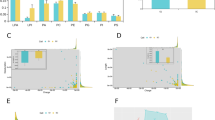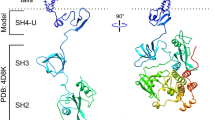Abstract
The cytoplasmic domain of the T cell receptor ζ subunit (ζcyt) is sufficient to couple receptor ligation to intracellular signaling cascades, but little is known about its structure or mechanism of signaling. In aqueous solution, ζcyt is unstructured. Here we report that in the presence of lipid vesicles ζcyt assumes a folded structure. The folding transition is reversible and dependent on the presence of acidic phospholipids. In the lipid-bound conformation, ζcyt is refractory to phosphorylation by src family tyrosine kinases, which are believed to play a key role in signal initiation in vivo. In the lipid-free, unstructured form, ζcyt is readily phosphorylated, and phospho-ζcyt exhibits neither membrane association nor structure induction. The conformational change may provide a mechanism for coupling receptor clustering to cytoplasmic signaling events.
This is a preview of subscription content, access via your institution
Access options
Subscribe to this journal
Receive 12 print issues and online access
$189.00 per year
only $15.75 per issue
Buy this article
- Purchase on Springer Link
- Instant access to full article PDF
Prices may be subject to local taxes which are calculated during checkout





Similar content being viewed by others
References
Weiss, A. & Littman, D.R. Cell 76, 263–274 (1994).
Chan, A.C. & Shaw, A.S. Curr. Opin. Immunol. 8, 394–401 ( 1996).
Reth, M. Nature 338, 383–384 ( 1989).
Clements, J.L., Boerth, N.J., Lee, J.R. & Koretzky, G.A. Annu. Rev. Immunol. 17, 89–108 (1999).
Irving, B.A. & Weiss, A. Cell 64, 891–901 (1991).
Romeo, C., Amiot, M. & Seed, B. Cell 68, 889–897 (1992).
Spencer, D.M., Wandless, T.J., Schreiber, S.L. & Crabtree, G.R. Science 262, 1019–1024 ( 1993).
Weissenhorn, W., Eck, M.J., Harrison, S.C. & Wiley, D.C. Eur. J. Biochem. 238, 440–445 (1996).
Davidson, W.S., Jonas, A., Clayton, D.F. & George, J.M. J. Biol. Chem. 273, 9443–9449 (1998).
Bryson, E.A., Rankin, S.E., Carey, M., Watts, A. & Pinheiro, T.J. Biochemistry 38, 9758–9767 (1999).
Beinert, D., Neumann, L., Uebel, S. & Tampe, R. Biochemistry 36, 4694–4700 (1997).
Epand, R.M. & Vogel, H.J. Biochim. Biophys. Acta 1462, 11–28 ( 1999).
Devaux, P.F. Biochemistry 30, 1163–1173 (1991).
Anderson, R.E., Standefer, J.C. & Scaletti, J.V. Lab. Invest. 37, 329–338 (1977).
Fridriksson, E.K., et al. Biochemistry 38, 8056– 8063 (1999).
Xavier, R. & Seed, B. Curr. Opin. Immunol. 11, 265–269 (1999).
Kim, J., Shishido, T., Jiang, X., Aderem, A. & McLaughlin, S. J. Biol. Chem. 269, 28214–28219 (1994).
Leventis, R. & Silvius, J.R. Biochemistry 37, 7640–7648 (1998).
Liu, L.P. & Deber, C.M. Biochemistry 36, 5476–5482 (1997).
Boniface, J.J., et al. Immunity 9, 459–466 (1998).
Cochran, J.R., Cameron, T.O. & Stern, L.J. Immunity 12, 241 –250 (2000).
Germain, R.N. Curr. Biol. 7, R640–644 (1997).
Hatada, M.H., et al. Nature 377, 32–38 (1995).
Rudd, P.M., et al. J. Mol. Biol. 293, 351– 366 (1999).
Chen, L., Pielak, G.J. & Thompson, N.L. Biochemistry 38, 2102– 2109 (1999).
Johnson, J.E. & Cornell, R.B. Mol. Membr. Biol. 16, 217–235 ( 1999).
Gilmore, A.P. & Burridge, K. Nature 381, 531–535 (1996).
Arnold, R.S., DePaoli-Roach, A.A. & Cornell, R.B. Biochemistry 36, 6149– 6156 (1997).
Cheng, H.C., Nishio, H., Hatase, O., Ralph, S. & Wang, J.H. J. Biol. Chem. 267, 9248– 9256 (1992).
Xu, W., Harrison, S.C. & Eck, M.J. Nature 385, 595– 602 (1997).
Acknowledgements
We thank W. Weissenhorn, S. Harrison and M. Eck for materials. This work was supported by a Career Development Award from the National Science Foundation (L.J.S.), a grant from the National Center for Research Resources for purchase of the BIAcore instrument, and a training grant from the NIH (D.A.).
Author information
Authors and Affiliations
Corresponding author
Rights and permissions
About this article
Cite this article
Aivazian, D., Stern, L. Phosphorylation of T cell receptor ζ is regulated by a lipid dependent folding transition. Nat Struct Mol Biol 7, 1023–1026 (2000). https://doi.org/10.1038/80930
Received:
Accepted:
Issue Date:
DOI: https://doi.org/10.1038/80930
This article is cited by
-
Who wins the combat, CAR or TCR?
Leukemia (2023)
-
Harnessing CD3 diversity to optimize CAR T cells
Nature Immunology (2023)
-
The interplay between membrane topology and mechanical forces in regulating T cell receptor activity
Communications Biology (2022)
-
Structural understanding of T cell receptor triggering
Cellular & Molecular Immunology (2020)
-
The intracellular lipid-binding domain of human Na+/H+ exchanger 1 forms a lipid-protein co-structure essential for activity
Communications Biology (2020)



